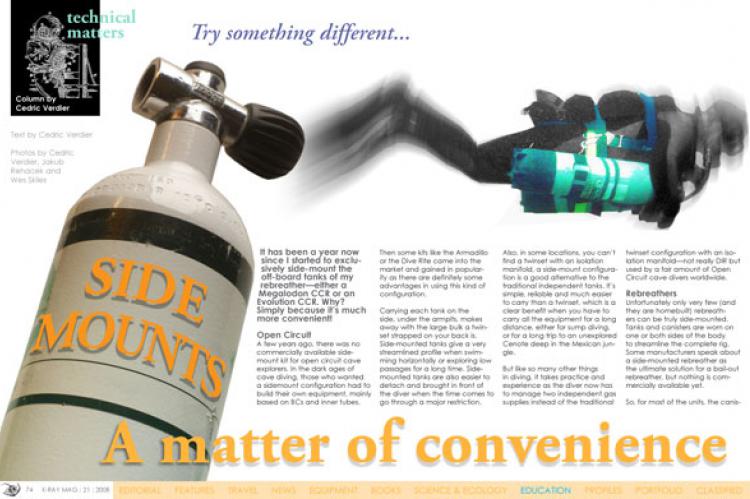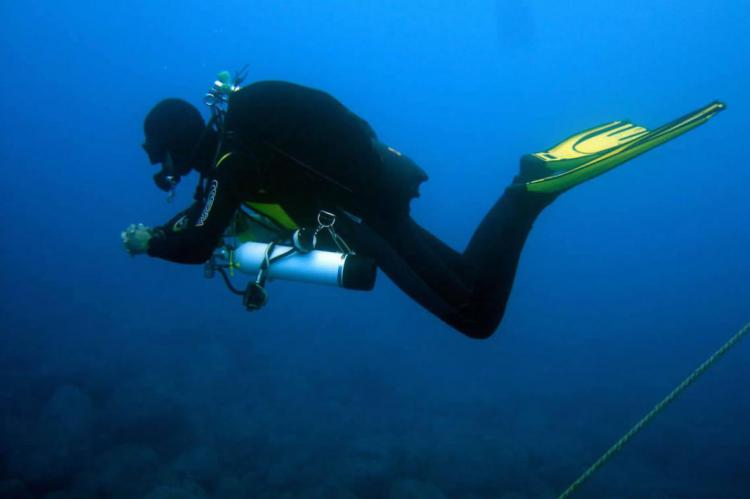Sidemounts - A matter of Convenience
It has been a year now since I started to exclusively side-mount the off-board tanks of my rebreather—either a Megalodon CCR or an Evolution CCR. Why? Simply because it’s much more convenient!
Tags & Taxonomy
Open Circuit
A few years ago, there was no commercially available sidemount kit for open circuit cave explorers. In the dark ages of cave diving, those who wanted a sidemount configuration had to build their own equipment, mainly based on BCs and inner tubes. Then some kits like the Armadillo or the Dive Rite came into the market and gained in popularity as there are definitely some advantages in using this kind of configuration.
Carrying each tank on the side, under the armpits, makes away with the large bulk a twinset strapped on your back is. Side-mounted tanks give a very streamlined profile when swimming horizontally or exploring low passages for a long time. Side-mounted tanks are also easier to detach and brought in front of the diver when the time comes to go through a major restriction.
Also, in some locations, you can’t find a twinset with an isolation manifold, a side-mount configuration is a good alternative to the traditional independent tanks. It’s simple, reliable and much easier to carry than a twinset, which is a clear benefit when you have to carry all the equipment for a long distance, either for sump diving, or for a long trip to an unexplored Cenote deep in the Mexican jungle.
But like so many other things in diving, it takes practice and experience as the diver now has to manage two independent gas supplies instead of the traditional twinset configuration with an isolation manifold—not really DIR but used by a fair amount of Open Circuit cave divers worldwide.
Rebreathers
Unfortunately only very few (and they are homebuilt) rebreathers can be truly side-mounted. Tanks and canisters are worn on one or both sides of the body to streamline the complete rig. Some manufacturers speak about a side-mounted rebreather as the ultimate solution for a bail-out rebreather, but nothing is commercially available yet.
So, for most of the units, the canister has to be carried on the back. Therefore mounting the cylinders on the side doesn’t really change much in regards to streamlining. Or does it?
In fact, most of the Closed Circuit Rebreathers on the market use very small on-board cylinders either inside the casing or simply attached to a central canister. In either case, side-mounting these tanks do not make much of a change. You can save a little bit of space on your back, but then you need longer LP hoses everywhere, and it becomes difficult to keep your rebreather as simple as possible. I tried it and didn’t like it.
On the other hand, side-mounting comes in really handy when it comes to changing the position of the off-board sling tanks and bail-out tanks that most rebreather divers carry with them. Most of the divers rely on the Open Circuit bail-out option as the last resort to come back to the surface alive, and it often means carrying at least one or two tanks. They are usually clipped on the chest and waist D-rings and, honestly, it’s not a good place for them. Their valves protrude, and the cylinders push on the front-mounted counterlungs, increasing the Work Of Breathing and uselessly opening the OverPressure Valve.
Anatomy of a Side-mount kit
The “butt-plate”: The core of the kit is an additional plate attached to the bottom of the usual backplate as an extension to clip the lower part of the tanks. The upper part of the tanks is simply held by a big bungee loop coming from the top of the backplate. The goal is to hold the tanks just under the armpit along the axis of the body.
The off-board tanks
Instead of a sling tank rig, the attachment is very simple. A cam-band with a dog clip is positioned in the middle of the tank (depending on the size of the tank and the diver). This clip will be connected to the “butt-plate”. No hardware is really necessary on the tank valve as the bungee loop does all the work. Nevertheless, some people prefer to have a clip here, mainly when they carry the tank on land or want to stage it somewhere.
The cam-band can also be used to put a lead weight to offset the buoyancy of the tank. With an aluminium 80 (11 liter), it’s only necessary for an Open Circuit diver who will breathe the gas in the tank. A full bail-out tank (that is not supposed to be used during the dive) will stay neutrally buoyant all dive long.
The regulators
First stage and second stage, a small SPG and a LP hose with a quick connect fitting (if the rebreather has this option). That’s it. It could also be convenient to configure two regulators symmetrically when two tanks are carried. It helps to have both second stages and LP hoses at the place.
How to use it
I toyed around with the idea of a sidemount kit for my CCRs for quite a while. My first attempt was a homebuilt project based on an old OMS butt-mounted EDS (the soft plate you use to store SMBs and small canister) I found in Thailand. The idea was good, but the final result didn’t last more than 20 dives. Everything fell apart during a dive. That was all it took to convince me that while the configuration was clearly interesting for a rebreather diver, the manufacture had to be much stronger.
My next project was to use the local Thai industry, find a small workshop that could understand my poor drawing skills and my even poorer Thai ....
(...)
Download the full article ⬇︎

Originally published
X-Ray Mag #21
Tawali on Papua New Guinea is narrated by Andrey Bizyukin and supplemented with photographs by Wulf Koehler. In the Mediterranean we visit the island of Elba. Leigh Cunningham takes us into a cave under Ras Muhammad (Egyptian Red Sea). Now where things are heating up, learn what Temperature really means. Or what goes on with Sex on the reef. No February issue without Valentines' gifts. We interview Richard Pyle about ecology, rebreathers, Pyle stops and being a nerd.



